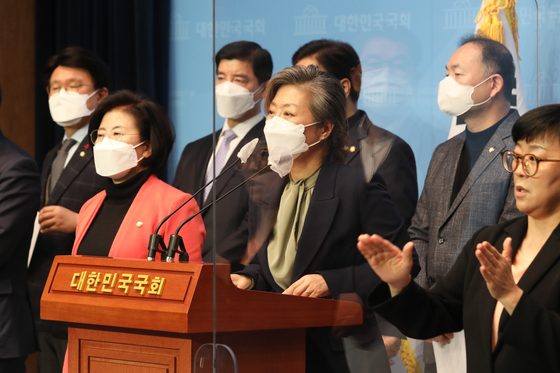
Democratic Party lawmaker Yang Lee Won-young speaks at a joint press conference on the’Unplanned Radioactive Material Leakage Case of Wolseong Nuclear Power Plant’ held at the National Assembly Communication Hall on the afternoon of the 13th. Reporter Oh Jong-taek
Controversy is growing as the political circles have added to the suspicion that the Wolseong nuclear power plant leaked tritium above the standard.
In addition, 19 members of the National Assembly, including the Democratic Party’s Environment Special Committee, held a press conference at the National Assembly on the 13th and announced that they would visit the Wolseong Nuclear Power Plant headquarters on the 18th to investigate the tritium leak. Prior to this, Lee Nak-yeon, the leader of the Democratic Party, even raised the responsibility of the auditor, which audited the early closure of Wolseong Unit 1, and criticized that “we must reveal whether or not the nuclear power plant has collusion with the mafia.”
However, the power of the opposition, the people, confronted with “mad cow disease season 2”, saying “the ruling party politicians spread fake news”. In an article posted on his social network service (SNS) on the 12th, Jeong Jae-hoon, president of Korea Hydro & Nuclear Power, also said, “It should not be that irresponsible content asserted by very few activists, rather than facts and scientific evidence-based controversy, should not spread in a way that blurs the comparison criteria again.” Refuted and raised controversy.
The Democratic Party and environmental groups point out that the Wolseong nuclear power plant produced a high concentration of tritium that exceeded the standard, but KHNP was not able to determine the cause. KHNP announced in April 2019 that 713,000 Bq (Becquerel) of tritium per liter was detected in the water accumulated in the manhole of the groundwater drainage (turbine gallery) under the turbine building of Unit 3. It is a high concentration 17.8 times higher than the emission standard of 40,000 Bq/L. Although it did not exceed the standard, a maximum of 28,200 Bq/L tritium was produced from the Wolseong Unit 2 sentry well.
Democratic Party lawmaker Yang Yi Won-young pointed out at a press conference on the day that “(where tritium came from) contaminated the site other than radioactive material management, and unintentionally spilled it.”
However, KHNP said, “The manhole from which the tritium came out is inside the radioactive material management site.” Wonheung University’s Wolseong Nuclear Power Plant Headquarters said, “The actual discharged to the outside and the water accumulated in the structure in the power plant management area are different concepts. This time, the stored water from which the high concentration of tritium was released is of course collected and disposed of in liquid waste storage,” he explained.
Previous cases of poor management at the Wolseong nuclear power plant were also discussed. Democratic Party lawmaker Woo Won-sik pointed out, “The damage expected in 2012 was confirmed only in August 2018 and has not been resolved.” In the process of reinforcing the filter and exhaust system (CFVS) of Wolsong Units 2-4 in 2018, KHNP confirmed the damage to the Spent Nuclear Fuel Tank (SFB) PVC (polyvinyl chloride) material barrier film of Wolseong Unit 1. KHNP estimates that at the time of the geotechnical construction of the Wolseong Unit 1 CFVS facility in 2012, two small-diameter piles have penetrated the water barrier and are undergoing reinforcement work.
In 2009, the part where gamma nuclides emerged from the SFB collection well of Wolseong Unit 4 was also raised as a problem. This is because, unlike tritium, gamma nuclides can be suspected of equipment damage if the particles are large and leaked. However, KHNP said, “The gamma nuclides discovered in April 2009 were safely treated in the liquid waste treatment system, and since the gamma nuclides do not come out of the collection tank, it is judged that there are no cracks and leaks.”
Meanwhile, Gyeongju City’s Wolseong Nuclear Power Plant/Shield Block Private Environment Monitoring Organization held an extraordinary meeting on the 13th, saying, “We will form a joint public-private investigation team led by the monitoring organization to end concerns.”
Sejong = Reporter Kim Namjun [email protected]
